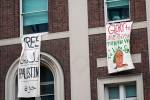Las Vegas Army retiree familiar with Gadhafi



Retired Army Col. Bill Olds knows how Col. Moammar Gadhafi operates.
After all, the Libyan tyrant put a $500,000 bounty on his head after Olds led Egyptian forces in the capture of Libyan hijackers in 1985.
Olds, 71, recounted the hijacking and the bounty while sitting in his Las Vegas home, his residence since 1995.
"I was told I shouldn’t go back to the Middle East. That didn’t bother me," said Olds, who was a senior military officer in the U.S. Embassy in the United Arab Emirates for three years and later was a private contractor in Iraq and Afghanistan for six years. "If they’re going to get you, they’re going to get you."
He still isn’t worried about the bounty, because Gadhafi "has bigger fish on his platter than Bill Olds," especially with a rebellion in Libya.
Olds warned that the United States should steer clear of the civil war and leave it to Arab and African nations to deal with Libya.
"We, the United States, ought to keep our nose out of it and not try to force democracy or any other type of governance on the country. And I say that because if (Gadhafi) died tomorrow or left tomorrow, they don’t have anybody or any party that knows anything about democracy. Another tyrant would come in, and it would be a vacuum for al-Qaida and the Muslim Brotherhood to step forward. Maybe he’s a bad guy, but he’s the best act they have in town right now."
Olds, who served three tours in the Vietnam War, became a specialist on Middle East affairs. He learned to speak Arabic at the Defense Language Institute in Monterey, Calif., which helped him land an assignment in Cairo in 1983 as Army chief of the U.S. Embassy Office of Military Cooperation.
"I was adviser to Egyptian special forces, which means I coordinated the training and the equipment they needed between Cairo and our special forces in the United States," said Olds, a Hawaii native, who was typecast to play a North Vietnamese general in John Wayne’s 1968 movie "The Green Berets."
The embassy assignment put him in the spotlight of an international crisis during the hijacking of an EgyptAir passenger jet. Libyan terrorists working for Gadhafi commandeered the Boeing 737 on Nov. 23, 1985, after it left Athens for Cairo and forced it to land on the island nation of Malta, a 220-mile hop across the Mediterranean Sea from Tripoli on Libya’s coast.
"Politically during that time, Egypt and Libya weren’t on very good terms," Olds said. "About that time, Gadhafi was on a roll doing different types of what we call terrorist activities. All of a sudden he decided to get back at Egypt, so he decided to kidnap an Egypt airplane."
Gadhafi had been in power since 1969, when he led a military coup that overthrew King Idris. Eight years later, his forces crossed into Egypt in the short-lived Libyan-Egyptian War, but Gadhafi retreated after Egypt returned fire.
That was followed by a period in the 1980s when he hired recruits to assassinate his critics around the globe and even considered assassinating then-President Ronald Reagan, who had called him "the mad dog" of the Arab world. The United States banned Libyan oil imports in 1982.
GETTING THE CALL
At 6 a.m. on Nov. 24, 1985, the phone rang at Olds’ Cairo apartment. It was his commander, Maj. Gen. Robert D. Wiegand: "Bill, an Egyptian airplane has been hijacked."
They met with Ambassador Nicholas Veliotes, who said Egyptian President Hosni Mubarak and his defense minister wanted them and another U.S. officer to accompany a contingent of Egyptian commandos to Malta.
Wiegand suggested changing out of their business suits and into combat uniforms. But Olds thought about it and talked to his Egyptian counterparts.
"I went to him and said I didn’t think it was a good idea that three Americans would go in their military uniforms. So we went in civilian clothes," Olds said. "I told him we shouldn’t take weapons. I anticipated that when we got off the plane there would be a lot of Maltese officials. And, I didn’t think it would look very good for the Egyptians and anybody else to see three Americans, high-ranking Americans, carrying weapons and looking like we’re going to combat. That wasn’t our job."
Instead, their job was to advise the commandos on how to carry out whatever plan they had.
"If in fact they needed outside help, American help, our job was to act as a liaison between Maltese officials and the U.S. government," Olds said.
ON THE GROUND
An Egyptian military C-130 took off with about 20 Egyptian special forces soldiers and the three Americans. It was joined by four F-16 Falcons from the USS Coral Sea aircraft carrier, which escorted the cargo plane to Malta’s Luqa Airport.
"As soon as we landed, the Maltese saw everybody and they asked, ‘Who are those people in civilian clothes?’ When they found out we were American military, they didn’t quite like that," Olds said. Maltese authorities "didn’t want to get blamed for having Americans there."
"The big thing is they didn’t want Gadhafi and the Libyans to think they had called for us and we were on their side to take down the Libyan hijackers," Olds said. "Once again it was a political thing. And geographically, one has to realize that Malta is just a small island not very far from Libya. Gadhafi could easily do anything he wanted to do."
The hijacked EgyptAir Flight 648 had taxied to an isolated spot on the runway.
During the flight from Athens, the hijackers had used passports to determine each passenger’s nationality. One, an armed security guard from the Egyptian air force, shot and killed one of the terrorists, triggering a brief, mid-air gunbattle that ended when he was wounded. Olds and the commandos didn’t know what had taken place inside the plane.
After the C-130 parked a safe distance away, Olds stayed with the commandos, who set up a command post in a secluded area about 500 yards from the hijacked jetliner. The other two U.S. Army officers went to the American embassy and then returned to stay in the air traffic control tower.
MAKING A PLAN
"We proceeded to war-game an entire plan with various options as to what we’d do if certain things would happen," Olds said. "In this case, they had shot a couple people on the aircraft before we got there and their bodies were thrown out on the tarmac."
The hijackers made demands through radio communications from the cockpit.
"They wanted water. They wanted food. And they wanted a few other supplies," Olds recalled. "So this gave us a good opportunity to use some of our people to go to the aircraft under the guise of being either medics, supply people, or water people."
A truck was sent to refuel the plane.
"One or two Egyptians would go along — they would be disguised — just to get the lay of the land and to try to get an idea where the hijackers were on the plane, and get an idea of the best places that we could penetrate the aircraft if we wanted to."
In all, the undercover Egyptians had made five trips to the plane and were able to position four commandos under its belly, out of view of the hijackers.
At 10 a.m., a hijacker had strong-armed an American woman, taking her to an exit door to shoot her in the head . She fell to the tarmac unconscious but was recovered by the commandos.
Unbeknown to Olds, the woman was Jackie Pflug, a U.S. teacher who worked in Cairo and played on a softball team he coached. Although seriously wounded, she survived.
By 11 a.m., it was clear the hijackers weren’t going to cooperate with negotiators and would kill a passenger every 10 minutes until the plane was refueled.
"The Egyptian commander had made a decision, which is they weren’t going to get any closer, or inside the aircraft, and any negotiation that was going on that the hijackers weren’t going to give in," Olds said. "So, he made a decision that he was going to take down the aircraft."
Olds remained at the command post, confident in the commander’s decision.
"I didn’t want to see anymore unnecessary killings or deaths," Olds said.
"On the other hand knowing the personality of hijackers, the longer they are in a situation like this, the more impatient they get. … They get to the point they will inflict more casualties, or just commit suicide by blowing the plane up if they had the capability."
THE ASSAULT
Olds knew the Egyptian commander had a good plan to assault the aircraft. "But a good plan doesn’t mean it’s always a successful one and no one gets hurt."
The plan was for the commandos to enter an emergency exit door over a wing while faking an attack on the rear and forward cabin doors.
"When that happened … all hell broke out on the aircraft," he said. "The hijackers started firing all over thinking there was going to be an attack from three places. When something like this happens, there is always going to be innocent people killed, and that’s what happened."
A 25-minute gunbattle and small fire sent smoke through the cabin. After it cleared, 60 people, including those from previous shootings, were dead. The commandos killed half of the dozen or so hijackers. The rest were wounded or captured.
The command post dispatched ambulances and emergency vehicles to evacuate survivors. After the ordeal was over, Olds inspected the jetliner.
"I saw a lot of hysteria, a lot of carnage, but the Egyptians had stabilized the situation the best they could under these circumstances. They were good at neutralizing and securing all the hijackers right away and then evacuating the seriously injured. They had rehearsed and practiced very well before this."
BACK TO NORMAL
As he looks back, Olds has concerns about U.S. involvement in Libya.
"If Gadhafi is calling a cease-fire, someplace down the line if the rebellious militia don’t step back and offer to negotiate with him, then it’s not going to work because he wants concessions from them and wants them to back off. If they don’t, the country’s still going to be in chaos, and he’s not going to able to pump oil and get back to normal."
Olds said the no-fly zone will work to keep Gadhafi’s aircraft grounded, but it will backfire if coalition forces go one step further and kill innocent civilians by attacking targets in air-to-land strikes.
"If there’s going to be any outside help, it should come from the Arab Union or the African countries around them, those countries that are most likely to be affected by this."
Olds said the revolts in Tunisia, Egypt, Bahrain, Yemen and Libya are similar but will differ in how or if they succeed.
"The commonality among all of them is they are young, educated kids influenced by Twitter, the Internet and Islamic fundamentalists. … They’re doing this in the name of civil rights, freedom and democracy. A lot of these things they don’t know about but it sounds good to the Western world."
Contact reporter Keith Rogers at krogers@reviewjournal.com or 702-383-0308.


















